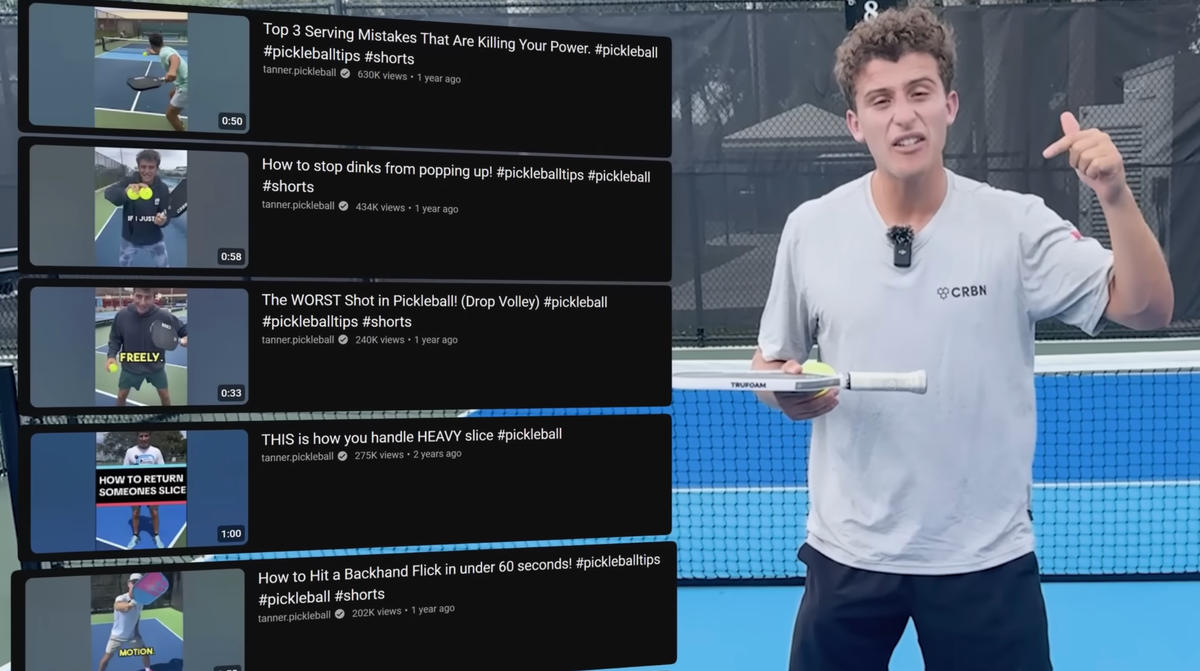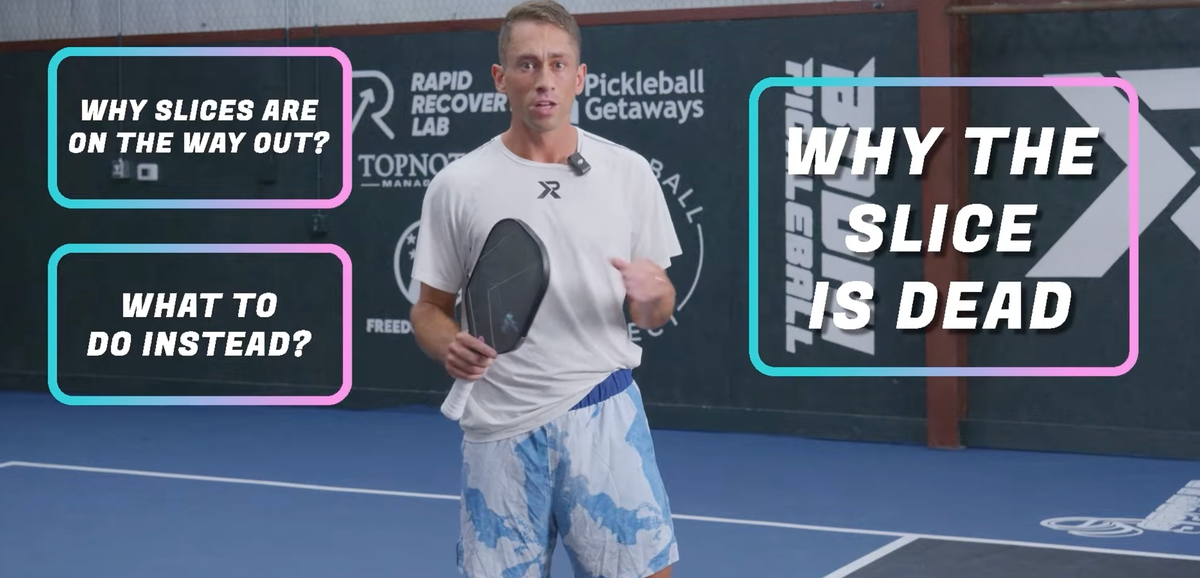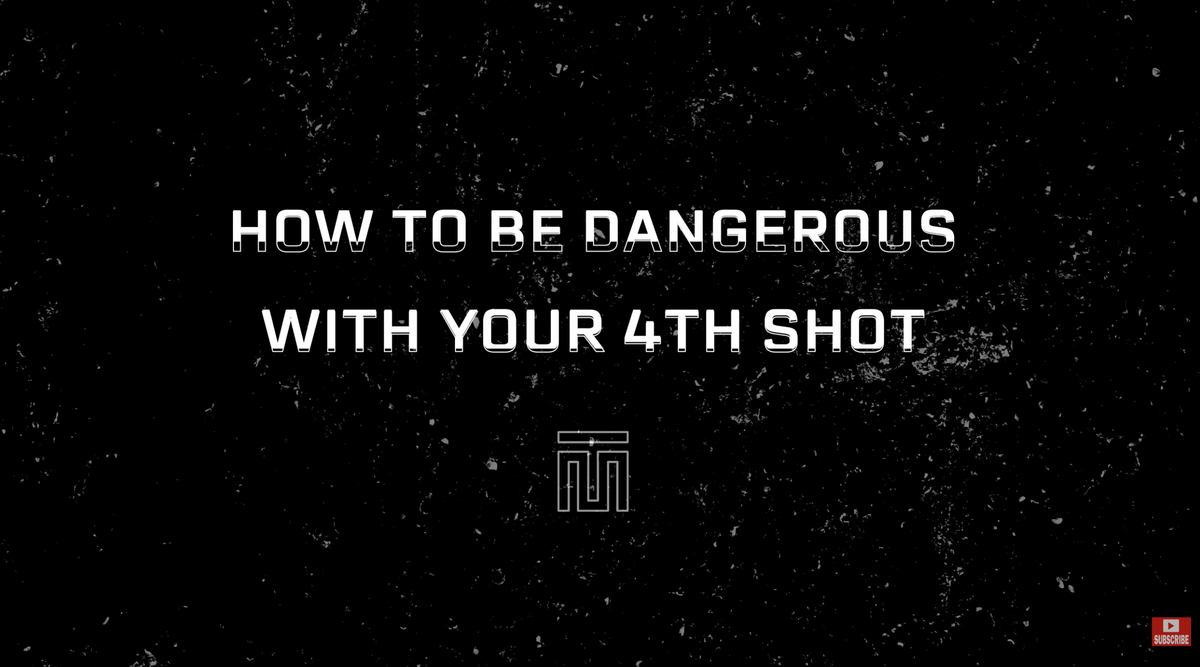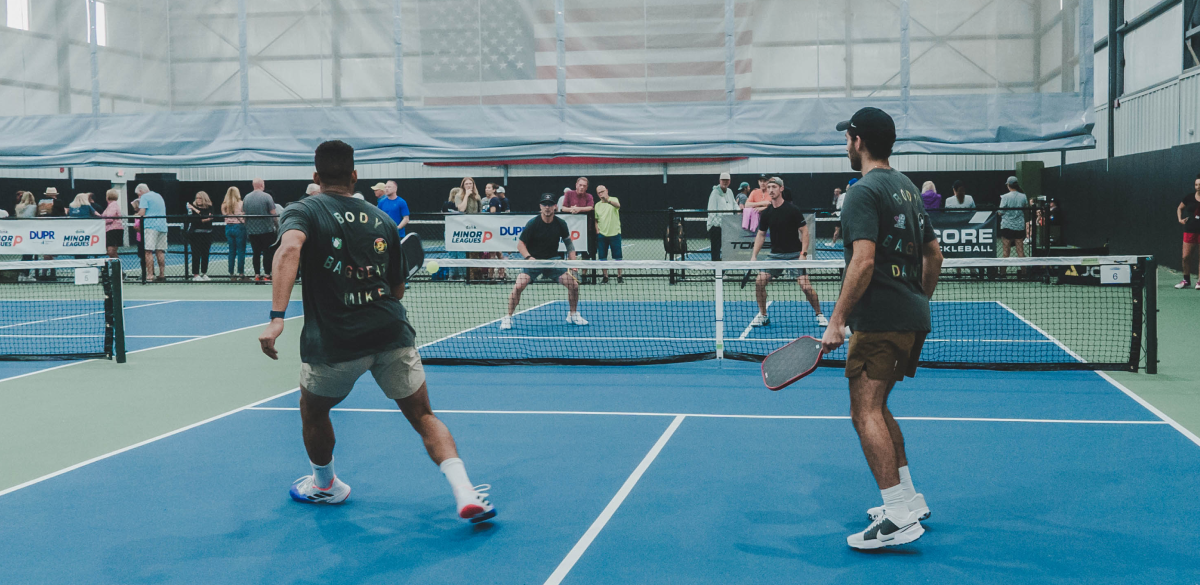 (Picture Kerry Pittenger)
(Picture Kerry Pittenger)Jump to
If you’ve just started playing pickleball you may be confused by some of the funny terminology used in the sport. We’ve compiled a complete list of lingo used in pickleball – including terms used to describe the court, equipment, scoring and other slang you might hear while playing the game. If you are looking for some practical in-action advice, follow Kyle or James. They write a lot about foundational insights and simple techniques that can really fast track your progress.
Pickleball Terms:
A
Ace: A serve that is not returned by the opponent. Point is won on serve without being returned.
Approach Shot: Ball is hit while moving in forward motion towards the pickleball net.
Around the Post (ATP) shot: When a ball is hit around the net post, usually with a lot of angle, without crossing over the net.
B
Backcourt: The area near the baseline, roughly the few feet inside the court from the baseline.
Backhand: Shot where player strikes the ball on the opposite side from their dominant forehand.
Backspin: Also called “Slice” or “Chop”, applying spin to the ball by striking it with high to low motion, causing the ball to spin in the direction opposite its flight direction.
Click here to see our list of the best pickleball paddles for spin.
WANT TO WIN A FREE PADDLE?
Sign up for a chance to win a free Yalla Paddle and receive pro player tips & exclusive content from top writers straight to your inbox.

Backswing: The motion of swinging the pickleball paddle back from the ready position before following through with forward swing.
Baseline: Line that forms the back end of the court, 22 feet on either side of the pickleball net.
“Bounce It”: Instructions called out to partner to not hit the ball and let it bounce (because you think it will land out of bounds).
Body bag or Tag: Hitting an opponent with the ball.
C
Carry: A shot where the pickleball does not bounce directly off the paddle but rather is carried along the face of the paddle during the forward swing.
Centerline: The line that extends from the Non-Volley Zone to the Baseline and divides the service court into two equal halves.
Champion Shot: A pickleball shot that bounces twice in the Non-Volley Zone.
Chop: Slice from high to low to put backspin on the pickleball.
Cross-court: The court area diagonally opposite your side court.
D
Dead Ball: A ball is declared after a fault; the point is over.
Dillball: Shot that is inbounds and has bounced once; a live ball.
Dink Shot: A soft shot that arcs over the net and falls into the opposing non-volley zone.
Distraction: Physical actions by a player that are ‘not common to the game’ that, in the judgment of the referee, interfere with the opponent’s ability or concentration to hit the ball.
Doubles: Pickleball game played between 4 people (2 on each team). Teams can be men, women or mixed doubles.
Double Bounce: A ball that bounces more than once on one side of the net before being returned resulting in a lost point.
Double Hit: Ball is hit twice by one team before returning over the net. Double hits may occur when the same player hits twice or can involve both players on a team.
“Down the Line”: A pickleball shot that travels near and parallel to the sideline.
Drive: A forehand shot hit straight and low, deep into the opposing backcourt.
Drop Shot: A soft shot that clears the pickleball net and then falls short of the opposing players.
Drop Shot Volley: A type of volley shot done to take speed off the ball and return it short, near the net when opponents are positioned at the baseline. This shot is especially effective when initiated close to the non-volley line.
Drop Spin: A shot that is chopped or sliced to drop sharply after it crosses the net; this is an advanced pickleball shot.
E
Erne: When a player lunges over the corner of the kitchen (Non-Volley Zone) out of bounds to get closer to the net and smash the ball without breaking the rule of placing one’s feet in the Non-Volley Zone before the ball hits the ground.
F
Face: The broad surface of either side of the pickleball paddle used to strike the ball.
Falafel: “Dead paddle” or a short shot due to hitting the pickleball ball with little or no power.
Fault: A fault is any action that stops play because of a rule violation.
Flick shot: When you flick your paddle downward as you extend your arm near the net and reach for a ball that otherwise would barely land in the kitchen and be difficult to hit with speed.
Flabjack: A midair pickleball shot that must bounce once before it can be hit during one of the first two shots of any point (the return of serve or return of the serve return). After the third shot, no bounce is necessary, and it can be volleyed (hit in midair without bouncing).
Flat Face: Keeping the pickleball paddle hitting surface parallel to the net.
Foot Fault: On the pickleball serve, at least one foot must be behind the baseline; neither foot may contact the baseline or court until after the ball is struck, breaking either of these rules is a serving foot fault. A Non-Volley Zone foot fault is when volleying a ball, the player steps in the Non-Volley Zone or steps on the line of the NVZ.
Forehand: Paddle stroke on the same side of the body as you are holding the paddle. A right-handed player’s forehand would start with their right hand behind them and follow-through across their body.
G
Game: A series of points played until one team has accumulated 11 points (winning by 2 points). Some pickleball tournaments play games to 15 or 21 points (win by 2).
Grip: The manner in which you hold the paddle handle with your hand (i.e., continental grip) or the material that is wrapped around the paddle handle to protect it and provide cushioning.
Groundstroke: Hitting the ball after one bounce (compare to a volley which is hit midair).
H
Half-Volley: A groundstroke shot where the paddle contacts the ball immediately after it bounces from the court. The ball is still low before it has risen to its maximum bounce height.
Head: Part of the pickleball paddle above the handle that includes the paddle face (hitting surface and paddle edge).
Hinder: Any element that interferes with play or an occurrence that affects play.
I
Inside-out: Shot across the court at an angle away from your body rather than across it.
J
Jammed up: The player is forced to hit the ball close to their body so their swing is impeded.
Junior: Player between the ages of 7 and 19. USAPA Juniors was created in 2016 to support these younger players.
Click to read more about Junior Pickleball and find the best paddles for Junior players.
K
Kamikaze: A player who charges the non-volley line aggressively while the opponent hits the ball, often to intercept a shot quickly.
Kitchen: Slang term for the Non-Volley Zone.
L
Let: A serve that hits the net cord and lands in the service court. Let serves are replayed, just as in Tennis.
Let Ace (or Lettuced): A serve that hits the net and still lands in the correct service area, resulting in an ace if the opponent is unable to return it.
Line Calls: Verbal indication said out loud indicating if the ball bounced inbounds or out of bounds. Normally players call the in/out on their side and opposing team makes calls on their respective side.
Live Ball: The period when the ball is actively in play, starting from the serve until a fault or dead ball is called.
Lob: A return shot sent as high and deep as possible, thereby forcing the opposing side back to the baseline.
M
Midcourt: The middle area on the pickleball court between the Non-Volley Zone and the baseline.
Momentum: When a player’s forward motion after a shot carries them briefly into the kitchen. This is legal unless the ball is hit.
N
Non-Volley Zone (NVZ): The 7-foot section of court on either side of the net. Pickleball players are not allowed to volley the ball in this zone. It includes all lines surrounding the zone. Also known as “The Kitchen” and the NVZ.
Nutmeg or 5-hole: When a player hits the ball through the opponent’s legs, a tricky and often surprising shot.
O
OPA!: Sometimes shouted out after the third shot has been hit; open volleying has begun.
Open Face: Holding the pickleball paddle tilted slightly upward.
P
Paddle: The equivalent to the racket in racquetball or tennis. Pickleball paddles can be made of wood, composite or graphite.
Passing Shot: A volley or groundstroke shot that is aimed at a distance from the player and is designed to prevent return of the ball.
Permanent Object: Any object around the pickleball court that could interfere with the flight of the ball. Permanent objects may include walls, fences, fixtures, lights, net posts, bleachers or spectator seating, the referee, line judges, spectators themselves, and all other objects around and above the court.
Pickle!: Warning shouted out by the server to alert all players on the pickleball court that they are about to serve.
Pickled: The equivalent to getting “skunked” in other sports, scoring zero points in a whole game. If you lose a pickleball game 11-0, you’ve been “pickled”.
Pickledome: Court where the championship match in a pickleball tournament is played. Something similar to center court in tennis.
**Continuing from the last point:
Pickler: A pickleball addict. A pickleball freak who can’t stop talking about the sport.
Poach: In doubles pickleball, to cross over into your partner’s side of the court to hit a shot.
Punch Shot: Quick, short volley shot with little backswing and short follow-through.
Punch Volley: A fast volley shot executed with a short backswing and a “punching” motion for speed and precision.
Put Away: A shot with no chance of being returned.
R
Racket/Racquet: See “Paddle” above.
Rally: Continuous play that occurs from the time the ball is served and until play ends in a fault.
Rally Scoring: A way of scoring where every side can earn a point, and the winning team of the rally gets the point and serves.
Ready Position: Ideal position to receive the ball for return. Paddle is out in front of the player’s body and up at chest height with a neutral grip for either forehand or backhand return. Weight is evenly balanced and weight on toes with knees slightly bent and ready to move in any direction.
Click here for strategy tips on the Best Ready Position in pickleball.
Receiver: Player diagonally opposite from the server who will return the serve.
Replay: Any rally that is replayed for any reason without the awarding of a point or a change of server.
Resetting (or Reset): To stop a hard/fast rally and bring it back into the kitchen for dinking.
S
Second Serve: The second serve by one team after having faulted on their first serve.
Serve: An underhand stroke used to put the pickleball into play. Serving team has two attempts to serve the point. Paddle must contact the ball under the server’s waist level.
Click here to see the #1 Tip To Instantly Improve Your Pickleball Serve!
Server Number: The number (1 or 2) indicating which server is serving for each team in the pickleball serving sequence.
Service Court: The area on either side of the center line, bounded by the non-volley line, the baseline, and the sideline. All lines are included in the service court except the non-volley line.
Service Out Side Scoring: The current scoring system used in Pickleball where you need to be serving to score points.
Shadowing: The strategy in Pickleball of moving in tandem with your team partner, keeping roughly 10 feet between each other. Both players move laterally, approach the net, or retreat to the baseline together in sync.
Sideline: The lateral border of the pickleball court delimiting the playing zone from the out-of-bounds area.
Side Out: Declared after one side loses its service and the other side is awarded the serve.
Singles: Playing pickleball with only 2 players, one player on each side.
Skill Level Rating: A measure of a player’s skill, typically used to determine appropriate partners and opponents in matches.
Slice: A chop shot used to create backspin on the ball.
Slammers: Hard-hitting aggressive players who rely on overpowering shots to put points away.
Smash: Shot that is hit above the hitter’s head with a serve-like motion. It is also referred to as an overhead.
Split Stance: Position with feet separate and parallel in the “ready position” to return the ball.
Split Step: When a player has a slight and consistent bounce with their feet so they are ready to react quickly and move in any direction.
Stacking: A doubles offensive formation in which the two players are on the same side of the court before the serve or return and then shift into a spot they feel more comfortable with after the ball is in play.
Stroke: The swinging motion of striking the pickleball with the paddle (i.e., forehand stroke, backhand stroke, groundstroke).
T
Technical Foul: In tournament play, the referee may add a point to a team’s score when the opponent violates one of the rules calling for a technical foul other than standard faults in play. For example, abusive language or unsportsmanlike play.
Technical Warning: An initial verbal warning issued by a referee for minor rule infractions or unsportsmanlike behavior before escalating to a technical foul.
Third Shot: The second return after the serve, often strategically used to gain an advantageous position.
Top Spin: Applying spin to the ball from low to high causing the pickleball ball to spin in the same direction as the flight of the ball.
Transition Zone: An area between the baseline and the non-volley zone line that serves as a middle ground as players move from far hitting shots to dinks near the non-volley zone.
Two Bounce Rule: In pickleball: after the ball is served, the receiving team must let the ball bounce before returning, and then the serving team must also let it bounce before returning. After the third hit, the ball can be volleyed (hit midair without bouncing).
Click here to read a more detailed explanation of the Two Bounce Rule.
U
Unattackable ball: A good drop shot or dink shot or reset shot that does not bounce high enough to be attacked (bounce height is lower than the net).
V
Volley: Hitting the ball in the air before the ball has a chance to bounce onto the pickleball court.
Volley Llama: Term referring to an illegal move (fault) where a pickleball player hits a volley shot in the Non-Volley Zone.
Anuncie Aqui / Advertise Here
Sua marca para o mundo Pickleball! / Your brand for the Pickleball world!

 English
English  Spanish
Spanish  Portuguese
Portuguese  German
German  Italian
Italian  Japanese
Japanese  French
French  Polish
Polish  Russian
Russian  Netherlands
Netherlands  Hungarian
Hungarian  Turkish
Turkish  Videos
Videos  Pickleball Portal
Pickleball Portal








 English (US) ·
English (US) ·  Portuguese (BR) ·
Portuguese (BR) ·